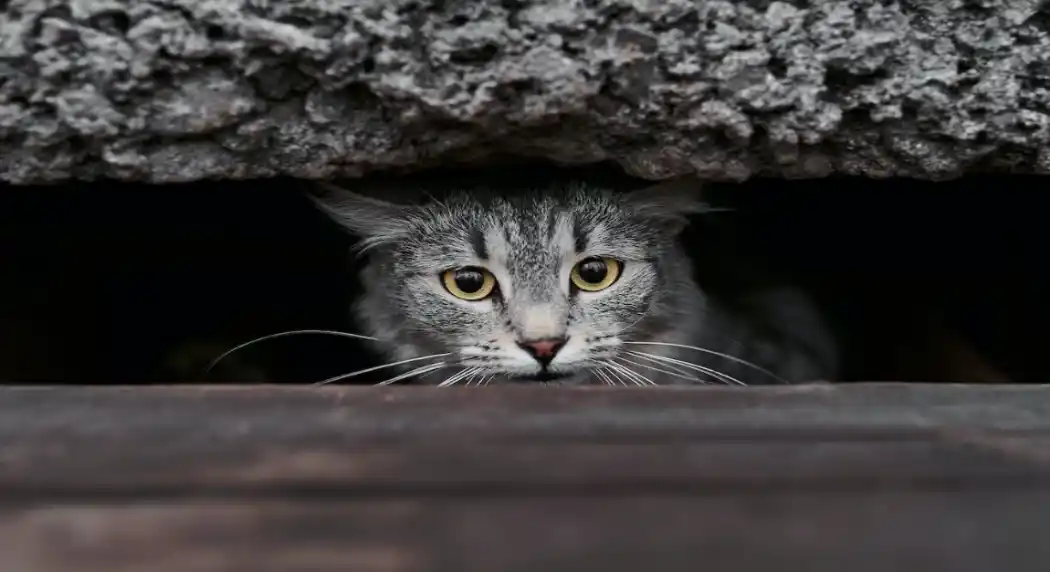How to create a safe space for your cat?

Published by: Tatsiana Korshik
Time to Read: 6 Min

How to create a safe space for your cat?
Creating a safe space for your cat is essential to provide them with a secure and comfortable environment. Here are some steps to help you create a safe room for your cat:Choose a suitable room: Select a quiet and less frequented room in your home that can serve as a dedicated space for your cat. It should have a door that can be closed to prevent other pets or people from entering.
Remove hazards: Ensure the room is free of any potential hazards that could harm your cat. Remove toxic plants, electrical cords, small objects that can be swallowed, and any other dangerous items.
Provide essential resources: Furnish the room with your cat's essential needs. Include a litter box, water bowl, and comfortable bedding or cat bed. Ensure the litter box is placed away from the feeding area to maintain cleanliness.
Offer hiding spots: Cats appreciate having hiding spots where they can retreat and feel safe. Provide boxes, cat condos, or blankets draped over furniture to create cozy hiding places for your cat.
Enrichment and entertainment: Include toys, scratching posts, and interactive toys in the room to keep your cat mentally stimulated and entertained. Rotate toys regularly to prevent boredom.
Secure windows and doors: Check that windows are securely closed or have screens to prevent accidental escapes. Ensure the door can be closed and has a secure latch to keep your cat safely inside the room.
Comfortable temperature and lighting: Maintain a comfortable temperature in the room, ensuring it's neither too hot nor too cold for your cat. Provide natural light or use soft lighting to create a soothing atmosphere.
Spend quality time: Visit the safe room regularly to spend quality time with your cat. Engage in interactive play sessions, grooming, or simply sit and offer affection. This will help your cat associate the safe room with positive experiences and your presence.
Remember, a safe room is not a substitute for allowing your cat to explore the rest of your home. It should serve as a dedicated space where your cat can retreat to when they need privacy, security, or time alone. Regularly assess your cat's needs and gradually introduce them to other areas of your home once they feel comfortable and confident.
Why Your Cat Needs a Safe space?
Cats, by nature, are territorial animals that value their personal space. Providing a safe space for your cat is crucial for several reasons:Security and comfort: Cats need a place where they feel secure and comfortable. Having a safe space allows them to retreat and relax without feeling threatened or overwhelmed. It provides them with a sense of ownership and control over their environment.
Stress reduction: Cats can be sensitive to changes or stressors in their surroundings. Having a designated safe space gives them a refuge to escape from loud noises, visitors, or other pets, reducing their stress levels and promoting overall well-being.
Privacy and solitude: Cats are known for their independent nature and occasional need for solitude. A safe space provides them with the privacy they require for activities such as grooming, resting, or observing their surroundings without feeling constantly observed or disturbed.
Establishing territory: Cats have a strong instinct to establish their territory. A safe space serves as their territory within your home, allowing them to mark it with their scent and feel a sense of ownership. This can help prevent territorial conflicts with other pets in the household.
Multi-cat households: In households with multiple cats, each cat should have its own safe space to retreat to. This helps reduce tension, competition, and potential conflicts among the cats. It allows each cat to have their own territory and resources, reducing stress and promoting harmony.
Introduction of new stimuli: A safe space can be particularly useful when introducing new stimuli or changes to your cat's environment. It provides them with a familiar and controlled environment where they can gradually adjust to new experiences, such as new pets, visitors, or rearranged furniture.
Health and well-being: A safe space promotes the overall health and well-being of your cat. It offers them a place to engage in natural behaviors, such as scratching, stretching, and hiding. It also allows for the inclusion of environmental enrichment items, like toys and scratching posts, which keep them mentally stimulated and physically active.
By providing a safe space for your cat, you create an environment that supports their natural instincts, reduces stress, and promotes their overall happiness and contentment. It allows them to have a space of their own where they can feel secure, relax, and recharge.
How to Choose a Safe space?
When choosing a safe space for your cat, consider the following factors to ensure it meets their needs:Quiet and secluded: Select a room or area in your home that is away from high traffic areas, loud noises, and frequent disturbances. Cats prefer quiet and peaceful environments where they can relax without disruptions.
Accessibility: Choose a safe space that is easily accessible for your cat. It should be located on the same level as their food, water, and litter box, making it convenient for them to fulfill their basic needs without much effort.
Adequate size: The safe space should be spacious enough to accommodate your cat comfortably. They should have enough room to move around, stretch, and engage in natural behaviors. Avoid confining them to small, cramped spaces that may cause stress or discomfort.
Lighting and ventilation: Ensure the safe space has proper lighting and ventilation. Natural light is ideal, as it helps regulate the cat's internal clock and promotes their overall well-being. Adequate airflow prevents the room from becoming stuffy or humid.
Consider the view: Cats enjoy observing their surroundings from a safe vantage point. If possible, choose a safe space with a window or elevated spot where your cat can look outside. It allows them to watch birds, squirrels, or other outdoor stimuli, which can be mentally stimulating for them.
Safety measures: Take safety precautions to make the space secure for your cat. Remove any toxic plants, ensure windows are secure or have screens, and eliminate potential hazards such as exposed cords or small objects that can be ingested. Create a cat-friendly environment that minimizes risks.
Comfortable amenities: Provide comfortable amenities within the safe space, such as cozy bedding, a scratching post, interactive toys, and a hiding spot. These items enhance their comfort, mental stimulation, and overall well-being.
Gradual introduction: When introducing a new safe space, give your cat time to explore and adjust to it at their own pace. Gradually introduce them to the space by leaving the door open and allowing them to enter voluntarily. Encourage positive associations with treats, praise, or playtime.
Remember that cats have individual preferences, so observe your cat's behavior and adjust the safe space accordingly. They may have specific preferences for certain locations or types of hiding spots. By considering their needs and preferences, you can choose a safe space that provides them with the security, comfort, and stimulation they require.
What to Put in Your Cat’s Safe space ?
When creating a safe space for your cat, it's important to provide them with essential items and enriching elements. Here are some things to consider putting in your cat's safe space:Comfortable bedding: Place soft, cozy bedding in the safe space where your cat can curl up and relax. This can include a cat bed, blankets, or cushions.
Litter box: Ensure there is a clean litter box available in the safe space. Cats prefer to have a separate area for elimination, so having a litter box accessible in their safe space promotes good litter box habits.
Water and food bowls: Provide fresh water and food bowls in the safe space. Make sure they are easily accessible and regularly replenished. Separating the water and food bowls can prevent spillage and contamination.
Scratching posts: Cats have a natural instinct to scratch. Including a sturdy scratching post or cat tree in the safe space allows them to fulfill this behavior and helps keep their claws healthy.
Interactive toys: Stimulate your cat's mind and provide entertainment by including interactive toys in the safe space. Toys such as puzzle feeders, balls, wand toys, or catnip toys can keep them engaged and mentally stimulated.
Hiding spots: Cats often appreciate having hiding spots where they can retreat to when they want privacy or feel anxious. Offer options like cardboard boxes, cat tunnels, or cozy nooks where your cat can feel secure and hidden.
Elevated perches or shelves: Cats enjoy being in elevated positions to observe their surroundings. Consider adding cat shelves or perches near windows or higher surfaces where your cat can relax and have a good vantage point.
Calming aids: Some cats benefit from calming aids, especially if they are prone to stress or anxiety. Consider using pheromone diffusers or sprays, which can help create a calming atmosphere in the safe space.
Enrichment items: Rotate and provide a variety of enrichment items to keep your cat mentally stimulated. This can include puzzle toys, treat-dispensing toys, interactive feeder balls, or even a window perch to watch outdoor activities.
Remember, every cat is unique, so observe your cat's preferences and adjust the items in their safe space accordingly. Regularly rotate toys and provide new stimuli to keep them engaged and prevent boredom. The goal is to create a safe and enriching environment that meets your cat's physical and psychological needs.
How to Use a Safe space?
Using a safe space for your cat involves creating a designated area where they can retreat, relax, and feel secure. Here are some guidelines on how to effectively use a safe space for your cat:Introduce the safe space gradually: Allow your cat to explore and become familiar with the safe space at their own pace. Keep the door open initially and let them enter voluntarily. Encourage them with treats, toys, or praise to create positive associations.
Provide access and privacy: Ensure that the safe space is easily accessible to your cat at all times. Keep the door open or use a baby gate to allow them to come and go as they please. Respect their need for privacy and avoid disturbing them when they are in their safe space.
Observe your cat's behavior: Pay attention to your cat's body language and behavior while they are in their safe space. It should be a place where they appear relaxed, comfortable, and at ease. If they seem stressed or anxious, assess the environment for potential stressors and make necessary adjustments.
Use positive reinforcement: Reinforce positive behaviors and associations with the safe space. Reward your cat with treats, praise, or playtime when they choose to spend time in their safe space. This helps them develop a positive connection with the area and encourages them to use it regularly.
Respect boundaries: Understand that the safe space is your cat's personal retreat, and they may need time alone. Avoid intruding or disturbing them when they are in their safe space. Respect their boundaries and allow them to use the area for relaxation and solitude.
Monitor and maintain the space: Regularly check the safe space to ensure it remains clean, comfortable, and free from potential hazards. Clean the litter box regularly, provide fresh water, and periodically wash the bedding. Remove any objects that may pose a danger to your cat's safety.
Adapt to your cat's needs: Cats' preferences and needs may change over time. Observe your cat's behavior and adjust the safe space accordingly. Offer new toys, replace worn-out items, or create additional hiding spots as per their preferences.
Consider gradual integration: Once your cat feels comfortable in their safe space, you can gradually introduce them to other areas of the house. Open doors or use baby gates to expand their territory, allowing them to explore at their own pace while still having access to their safe space.
Remember, each cat is unique, so adapt the use of the safe space to suit their individual needs and personality. It should serve as a place of comfort, security, and relaxation for your cat, promoting their overall well-being and happiness.
How Long to Use a Safe space?
The length of time to use a safe space for your cat can vary depending on their individual needs and circumstances. Here are some factors to consider when determining how long to use a safe space:Transition period: If you have recently brought a new cat or kitten into your home, it is advisable to use a safe space during the initial transition period. This period can range from a few days to a few weeks, allowing the new cat to adjust to their new environment and gradually become comfortable with other pets or family members.
Stressful situations: Cats may require the use of a safe space during stressful situations, such as moving to a new home, renovations, or hosting large gatherings. The safe space provides them with a familiar and secure environment to retreat to until the situation settles down.
Multi-cat households: If you have multiple cats, each cat may benefit from having their own safe space. This can help reduce tension, territorial conflicts, or competition over resources. In multi-cat households, safe spaces can be used long-term to provide cats with their own designated areas where they can feel secure and have privacy.
Individual preferences: Some cats naturally prefer having a safe space throughout their lives. They may enjoy having a place where they can retreat, relax, and have alone time. In such cases, the safe space can be used indefinitely as long as it meets their needs and provides them with comfort and security.
Gradual integration: Once your cat becomes more comfortable and confident in their environment, you can gradually integrate them into other areas of the house. This can be done by gradually opening doors, using baby gates, or allowing supervised access to new spaces. The safe space can still be maintained as a retreat option if your cat desires it.
It's important to assess your cat's behavior and well-being regularly. If you notice that your cat consistently seeks out and relies on their safe space as their primary comfort zone, it may indicate a long-term need for a dedicated safe space.
Ultimately, the duration of using a safe space depends on your cat's individual needs, temperament, and the specific circumstances they are facing. Pay attention to your cat's behavior, monitor their stress levels, and provide them with the support they need to feel secure and comfortable in their environment.



